Menus
- A compressor, 210 horsepower, 13.6 m / kg, € 26,000: is that really reasonable ?
- Will you be able to see raw power in the eye ?
- Discovery
- In the saddle
- In the city
- On motorways and main roads
- On departmental
- Part-cycle
- Brakes
- Comfort and duo
- Consumption / autonomy
- Conclusion
A compressor, 210 horsepower, 13.6 m / kg, € 26,000: is that really reasonable ?
Will you be able to see raw power in the eye ?
She made the H2 talk about her, just as much as she put Kawasaki back in the circle of producers of spooky machines. Because of the four Japanese manufacturers, Kawasaki is the one who has always produced machines that make headlines for their performance and character, motorcycles that are aimed at bikers who want to explore their dark side: remember, the 750 H2 of the early 1970s and their literally explosive three-cylinder two-stroke engine that earned them their nickname "Widowmaker" ! An unbroken line: Z 900 then Z 1000, ZX 1100, ZX 750 Turbo, 900 Ninja, the Z 1300 and its six cylinders, 1000 RX, ZZR 1100, ZX-12R, ZX10R, the list is long (and we forget some! ) of these machines which had this little "indomitable" side that other Japanese women did not have and who classified their owners as guys "who had", said like that to stay in the elegance, lightness and refinement. And poetry, too.

And here is the new H2. That Kawasaki takes the name of one of its legendary motorcycles announces the color: it will drop its mother !
Technically, on the other hand, nothing to see: goodbye cylinders with stinking holes, welcome to the compressor! Running at 130,000 rpm, it has only one mission: to feed the machine with horses. As your butcher-caterer would say: "there’s a little too much potato, I’ll give them to you anyway ?".
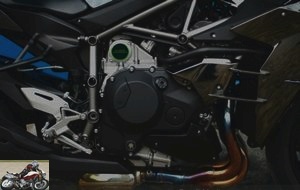
Drooping jaw, hanging tongue, dripping saliva: the H2 and above all, its non-homologated H2-R version which outright announces 326 horsepower and more noise at the exhaust than a MotoGP (130 dB), have everything to fuel the machine. fantasies of the one who observes them. Whether we like it or not, whether we consider that such machines have their place (or not) on our roads, that is not the question. We must salute Kawasaki for having dared to manufacture such a machine, for having succeeded in marketing it. So that all those who also love the Motorcycle for the sensations it provides can dream of taking it at least once on the handlebars to be able to answer this question: how does it feel ?
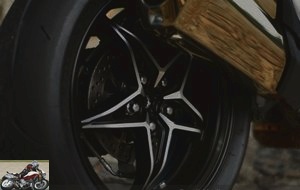
Discovery
After showing off in the Salons for almost two years, after languishing because of the specifics of our beautiful French law which prohibited us from accessing it, after having once again waited for this damn retrofit to be signed, here it is now authorized to ride on our beautiful radar-radar roads. And that changes everything: because surrounded by hostesses dressed on the carpet of a living room, she becomes the object of fantasies. On a speed circuit, such as the one in Qatar where my colleague, the illustrious Loïc, had the privilege of discovering it and making him spit out his horses, it seems to be in an environment tailored to its (dis-) measure. But there, in our streets, on our roads, the H2 has obviously all the monster in freedom.

From 2015 to 2016, the H2 has changed little: exit the green frame, now it is graphite and goes well with the "dark mirror" color that covers the machine. Only the small "SuperCharged" logo and the fork adjustment plates in the triple trees bring that little touch of green typical of the Kawasaki universe. For the rest, it is obvious that the H2 impresses: leave it in a parking lot or on the terrace of a cafe and it instantly hypnotizes and not just bikers. Even those who are not familiar with its technical characteristics guess that something unusual is going on. It suffices to see it from the front, with its two small nightlights incisively shark style, its LED lights, its stocky and collected look….
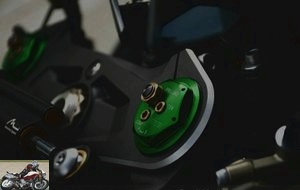
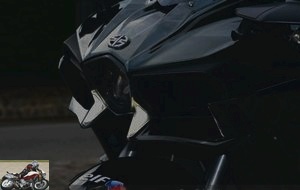
The others, those in the know, look at the owner with a dose of respect. Perhaps this is what the owner of a Kawasaki 750 H2 must have felt in the 70s, when he arrived in the middle of a group made up of CB 125 and Motobecane 350….

In the saddle
The driving position is almost that of a sportswoman, with the straps implanted quite low, but the position of the feet could be a little more back to make it perfectly coherent. The mirrors are wide, but they generally go below those of cars: that’s one less worry.
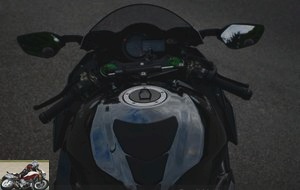
Kawasaki inaugurates new commodos which require a little time to adapt, with fairly thin buttons (the command of warnings, in particular).
Once the ignition is on, the first concern will be to make sure that the electronics are helping you to contain the cavalry. The dashboard is complete, but not necessarily super readable, with the tachometer figures which gradually light up with the rise of the needle, as well as a small, fairly dense digital window. So the priority goes on the level of traction control: starting at 3 is reasonable. Otherwise, there is also a "rain" mode … There is also a kind of baregraph under the "boost" logo. Know that when it kicks in, you won’t really have the opportunity to watch it so much.
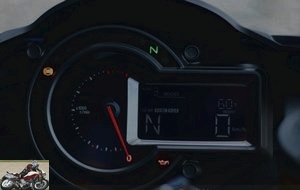
Despite the 238 kilos, the bike is well balanced and the weight is not really an obstacle when handling. The saddle located at 825 mm does not, however, put it within reach of the smallest riders..
In the city
The good news is that the monster is easily domesticated! The recipe: stay on a micron of gas and do not exceed 4000 rpm and take advantage of the flexibility of the 4 cylinders in line. Under these conditions, the H2 is a fairly frequent city.
Any biker used to commuting in sports (and there are often more than you think) will find his marks on the handlebars of the H2. Between the lines of cars, the turning radius is no worse than on other sports cars, the engine is relatively smooth, the controls are smooth and the sound is that of an almost classic in-line four, with some small metallic intonations. at low speed, but without excess for the ears of the neighborhood.
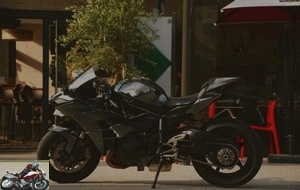
All is well on the big boulevards, then? Alas no, for the fault of an infernal neutral point to find at the stop … It happened to me to play between the first and the second all the time from the stop to the fire, without succeeding in finding this damn dead point! And with shoes or with boots, same punishment: damn recalcitrant box! Was this an isolated case? Tell us about your experience if you switch with an H2 … In any case, the gearbox does not pose a problem on the road with an efficient shifter and precise control, even if the clutch is used..
On motorways and main roads
One could imagine that with such a level of power and the help of the compressor, the H2 pulls long to give itself the air of a grand tourer. Well no ! It pulls rather short, with, in 6th, 4000 rpm at 90, 5800 rpm at 130 and 7000 rpm at 170 km / h, when some vibrations become quite sensitive in the saddle (this precision for our readers German, very numerous, we know it by the IP addresses) and more than 280 to 12 000 rpm (but that, do not ask me how I know it …).
So yes, you have to tell yourself, we’re getting a big deal for 200 horsepower, but after all, BMW S1000RR, Kawasaki ZX-10R or Yamaha R1, they also make 200 horsepower and we do not summon the fanfare to to speak. Yes, but there are the numbers on one side. And on the other, the way.

Let’s face it: the H2 reinvents the way you swing 200 horsepower in the rear end.
On a sports car, everything is done in the laps. If it is sustained, the acceleration remains generally adjustable and has something linear: each ten revolutions / minute corresponds to the delivery of a few tenths of additional horsepower..
The H2 is not like that: when the compressor starts blowing, at around 5,000 rpm, you take a boost that corresponds to what a sportswoman sends you from 10 to 12,000 rpm . The violence of the stuff is just indescribable. But the funny thing is, it doesn’t stop. On the contrary: from 10 to 14,000, the orgy of horses continues and stuffed with fresh air from the Ram Air, the H2 gives you its 210 horsepower at once, with revs that have no inertia. There, eyes glued to the back of your head, shortness of breath, maximum concentration, the landscape that scrolls past as in an attraction at Futuroscope, you do not understand what has just happened to you. Mum !

Since we are almost always in the power zone, H2 is action, reaction! Or rather, acceleration, teleportation !!! To put it bluntly, staying on high and going up two or three gears in a row is a bit of a challenge given the conditions and traffic on our roads (at least in the Paris region). Difficult to be precise for lack of sophisticated measuring device, but the slightest stretch is swallowed at lightning speed. But again: let’s say you enter a four-lane, by a slip road and that you are at low speed in third, at 70 km / h. Normal, what … You insert yourself, look well behind you and especially in front and there gas! You have to stay in third, because in second, with traction control on 3, it will create a garland on the dashboard and the electronics will regulate the acceleration. With the traction control on 2, it’s a little more permissive: enough to get a little power wheelie, but still controllable with the grip. The 200mm wide Brigdestone RS10 suffers to maintain grip, the acceleration is instantaneous, violent. Unfortunately, at 10,000 rpm, it strengthens up to 14,000 in the red zone, without any inertia. The front end of the H2 floats a little above the asphalt, the steering damper bumps to stay on course as soon as you pass over a bump. No time to look at the meter or gadgets like the boost display. Fourth with a shifter, without cutting the throttle: acceleration continues with the same violence. Fifth of a sudden shifter, still without cutting the throttle: the acceleration continues with the same violence. Does it ever end, this thing? Skip the 6, then? Good idea, except that there in a few hundred meters, say, 8 or 10 seconds, you are more than 250 km / h. In your emotion-saturated brain, the few cars that were on the horizon now seem to be aiming at you in reverse. If you don’t play this on the rare free portions of the German Autobahnen, your license is in jeopardy and you risk having your photo on the front page in the local newspaper. Unless the mirror paint reflects the radar beam. You never know, you can dream, no ?
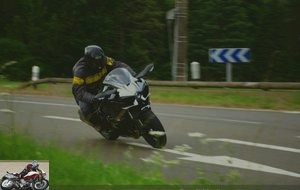
Otherwise, at legal speed, the H2 is no less uncomfortable than a modern sports car; it moderately protects the shoulders, but the sculpted sides of the fairing spare the legs from aerodynamic turbulence. But respecting the limitations is a real test which even the Dalai Lama would have difficulty in getting out of it without losing points … We take the bets. ?
On departmental
Precise front axle, racy position, high-performance tires: the H2 can be taken along rather easily and even manages to hide its weight, which flirts with the 240 kilos fully loaded. So, to wind up quietly, or to take a series of turns, all is well, with the suspensions that remain firm, but not brittle. Whether in the Chevreuse valley or on the small winding roads of the Belgian Ardennes, the H2 can be taken with the same ease as any Japanese 4 cylinder….

Although: it all depends on your intentions. Stroll ? Ok. Tourism? Very well ! Arsouille? There, it gets complicated and it will depend a lot on your level and your mind. Let’s not forget that H2 is just dynamite! On a winding course, the landscape squirts in your face and the H2 does nothing to make your life easier. Between the jerks of injection when the net of gas is restored in tight bends, the shifter is efficient, but which, if you shift your gears above 5000 rpm, gives you a direct blow from the compressor from the start. Upper gear engaged, teasing the H2 is not easy.

Fortunately, the electronics are on the lookout. We therefore praise the efficiency of the electronics and the ability of each level of settings to offer you a different environment. Rain or 3: you are safe, with electronics that control everything. Level 2: you can let go of the horses, the grip of the racing tire is expressed and the front rises sparingly under the sudden arrival of torque (already 8 m / kg at 4000 rpm …). Level 1: the wheelies become more violent when accelerating. Off: do you really want to try ?
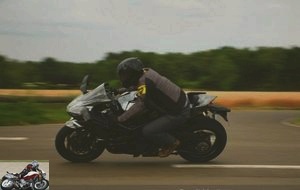
The H2 takes you into a new sensory universe, with the whistling and hissing sounds of the compressor, especially audible when decelerating between 8 and 4000 rpm. It is surprising at first, but it classifies the H2 in the machines apart … The bikers who watched us during the photo shoot were indeed surprised by the noises of the machine, between the ignition cuts during acceleration and the noise compressor: no doubts, we feel that we are dealing with something nasty…
Part-cycle
Kawasaki has not skimped on the material: a solid tubular chassis made up of tubes of variable diameter was designed for the R version and its more than 320 horsepower. Suffice to say that for the civilian version and its 210 hp (with the Ram Air), it’s velvet. In fact, even when accelerating like hell on bumpy roads, there is no stability problem. The Kayaba fork is fully adjustable, with brackets located on the triple tree that make the job easier. For once, the technology of this sports car comes from motocross: the Kayaba fork has separate air / oil cartridges that favor a certain progressiveness on braking attacks and firmness when you really hit it. Like the front, the rear shock is fully adjustable, with two settings for compression…
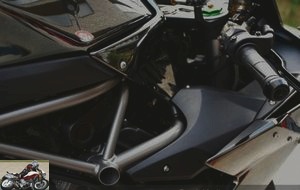
Brakes
Here too, Kawasaki provides: a double 330 mm disc at the front, with 4 piston calipers. Behind, it is a single disc, but with a diameter of 250 mm all the same, with double piston caliper. Dosage, power, precision, it’s all there. And even the style with a J. Juan master cylinder (as on the Kawasaki Superbike) and its transparent jar.

Comfort and duo
For the duo, it’s simple: there is BlaBlaCar and you find your other half in the evening, at the stage, she fresh and you, mentally drained! Regarding comfort, it’s also simple: the H2 is quite livable, in the "roller missile" genre, thanks to suspensions which leave a little dead travel and its 4 cylinders which can be flexible if it is not provoked. . For the rest, the long stages can be considered without fear, since we will see it in the paragraph below, they will never be very long in time..
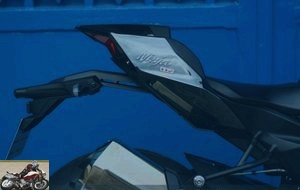
Consumption / autonomy
Because H2 consumes! It’s a fact and the only way not to consume too much is to drive below 4000 rpm, so as not to engage the compressor too much (but do we buy an H2 for that?) . In any case, the consumption is one of the subjects which annoys on the H2! On departmental, in eco-driving mode, I made 7.6 l / 100. By opening a little more: 8.2 l / 100. On the motorway, from 130 km / h (i.e. at the edge of 6000 rpm, as soon as the compressor starts to force-feed the engine), it is of the order of 9 l / 100. We dare not think of our German friends’ conso on their unlimited portions. 15, 20 l / 100? Likely. In short, with the 17 liters of the tank, I have always spent in reserve between 140 and 160 kilometers: trips to remote corners require a little planning of refueling.
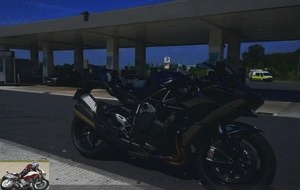
While we’re talking about what’s annoying, let’s mention the poor fate of the rear tire: the 200mm wide Bridgestone RS10 will have a hard time doing 1,500 kilometers if you tease, like us, this H2. It’s a budget !
Conclusion
Of course it is totally unreasonable, this Kawasaki H2! Soft at low speed (below 4000 rpm), it is doubly explosive, once around 5000 and a second, around 10 000. More than the figures, the data of the technical sheet, there is the way in which this demonic machine propels you forward with an energy that never seems to stop. Sure that in the offices of the lobbies of associations statically funded to howl wolf on the theme of road safety (Chantal Perrichon, the "Prof" Claude Got …), there would be heart attacks if one were able to understand how well this bike works (at the same time, it may be an opportunity to get rid of these old junk that has been rambling the same nonsense for decades).
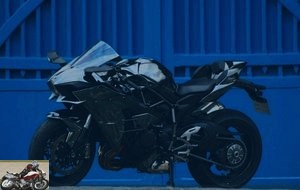
Because the H2 is intended for the fan of the beautiful object, the adrenaline addict, the biker who seeks transgression, the one who thinks he has seen everything and who is looking for a new trick to tame (and he will be served!).
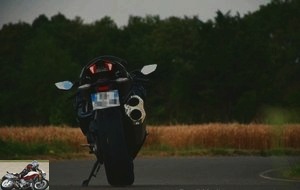
And at € 26,000, we can even take the risk of saying that it offers for the money. It is certainly 30% more than a modern 1000 sports car, but above all, it is a sensory universe unlike any other, the equivalent of a Lamborghini Aventador SP. The two-wheeled "Supercar", that’s it.

Strong points
- Amazing motor !
- New sensory universe brought by the compressor
- Acceleration = teleportation !!!
- Chassis that ensures
- Saving electronics
Weak points
- Infernal neutral point to find
- Should come with 5,000 license points
- Totally unreasonable !
- Consumption & autonomy
- Rear tire budget
- Injection jerks during go-around on small road
Kawasaki Ninja H2 technical sheet
Test conditions
- Itinerary: 1,400 kilometers in 7 days with daily use in Paris and a short trip to the Belgian Ardennes
- Motorcycle mileage: 4500 km
- Problem encountered: none, but to shoot a rear tire in 1500 km, I had never done before…
Competition: Lamborghini Aventador SP, Space Mountain, bungee jumping over a river with crocodiles, a motorcycle with a big turbo…
- All Kawasaki tests
Related articles
-
Evolution or revolution of the ER6-f with the in-line twin of 649 cm3, 68 horsepower for 193 kilos A more sporty look but, paradoxically, a gain in…
-
40 horses at 11,500 rpm 25.7 Nm, 175 kilos with full tank, two colors, € 5,799 An easy and sparkling little trail: what if life on a motorcycle was as…
-
The first big bike intended for beginners, 806 cm3, 95 hp adjustable at 47.5 hp Simple recipes for a beautiful rewarding machine In its great kindness,…
-
Rock’n roll attitude ! Sitting less than 70 cm from the ground, feet propped far forward and holding the wide handlebars of the VN 900, I taste the…
-
Kawasaki ZX10R motorcycle test
The motorcycle division of the giant Kawasaki industry, is only a drop in the sea, but that does not prevent it from being a major player in the world of…
-
Roadster with Sugomi sauce or decarenated sports car A2 licenses have the choice between large bridles, sometimes very badly bridled, and smaller ones,…
-
Kawasaki Ninja ZX-10R KRT motorcycle test
An integer character 4 cylinders in line, 998 cm3, 203 hp, 114.9 Nm, 206 kg all full facts, 18,099 euros. Nice surprise for me to find the Kawasaki…
-
Kawasaki ER-6 N motorcycle test
A very stylish and punchy little urban The city of Mozart sounded for three days of a superb symphony in major exhaust. Orchestrated by Kawasaki making…
-
Custom for all ! This Kawasaki hides its game well. Under its air of custom for young license, the Vulcan S is actually a fake roadster with a sparkling…
-
Kawasaki VN custom range tests
The beautiful chrome of East America In the motorcycling picture, the production of customs is, for many, the prerogative of an American brand. So much…
A racy bike, a very successful timeless line, perfect equipment (brakes, forks and suspensions), generous displacement, here is an explosive and tasteful cocktail, which should have lasting success..
Only downside, the meter block is too lying. Hence its poor visibility, and the absence of any protective aerodynamic effect.
Hi everyone,
Small return after a month, 1200 terminals and especially after installing low bracelets (at the level of the fork, and no longer above).
Well, aesthetically, you’ve seen the photos, there’s nothing to say. I get stopped even more often than in Ducati! Just that the low bracelets give it a little sportier air that fits it like a glove. All that is missing is the fairing of the fork crown to look even more like a 900 SS conical torque … but the Triumph price slows me down (1000 balls, do not bother the brittons).
Driving position
Nickel for my meter seventy-six. My feet are flat, the bike is super thin, which allows the tank to be squeezed optimally – very comfortable for a slightly sporty ride. With the low bracelets, I find the moderate pressure on the wrists that I had on the SSie, but the body is less stretched out and the arms less stretched. The advantage of leaning forward a little more is that you suffer (a little) less from the wind at high speed. Because, clearly, past 120 km / h it takes a lot of trouble! Without the fork crown, I really don’t see myself making a long highway trip with.
The a little weird thing is that the knees touch the cylinder heads and do not lodge in the notch of the tank. It does not bother me too much, even if, inevitably, it heats a little: D.
Motor
For once, let’s let the numbers speak.
Large twin cylinder set at 270 °, 97 hp, maximum torque at 5000 rpm, useful range from 2500 to 8000 rpm.
Does it remind you of anything? Yep, you’re right, we are really not far from the characteristics of the Ducati 1000DS (which is, I would remind the ignorant, the most fantastic engine of all creation). Only the torque (11.2 N.m) is noticeably different, but we will not complain, eh ?
In use, the generation difference is felt all the same: the engine does not express its dissatisfaction with being restarted below 2500-3000 revolutions / minute by a series of hammer blows worthy of a jackhammer. . We can’t say he likes it very much, but he does it without (too) complaining. Thank you for the extra torque, the very well-controlled injection, the short first gear … and the balancing flywheel.
On the other hand, once past the 3000 rpm … mom it sends! Up to 7000 rev / min without having time to see anything, the landscape scrolls at full speed and we are happy to have put the handlebars down (again). It seems that we lift the front wheel on the first three reports, it is undoubtedly true (not tested, and not want to do it).
We release the accelerator, the engine brake is present for a modern engine (less than the 1000 DS all the same). This is not enough ? We enter a gear, the engine is expressed in a delightful rumble, I keep my foot on the rear brake to correct the entry of a curve a little, it goes cream, I aim for the chord point … and I start again! It’s addicting this stuff! As on the SSie, I roll on small roads between third and fourth gear, hardly any need to touch the front brake (better, I’ll come back to that), it’s a real pleasure bike.
A regret, not necessarily on the engine but on the staging of the gearbox. It is ideal until the fourth. Then, well, it shows that the bike is designed for departmental and national road. At 120 km / h in sixth, I am at 4000 rpm. A motorway trip will be between 5 and 6000 rpm, not really the ideal speed and in addition, the right wrist is then found quite twisted downwards. Not annoying in punctual acceleration, but I doubt that I will hold several hundred terminals continuously. A longer sixth gear would in my opinion be quite interesting.
Handling
I left for a remake of the SSie (obviously, almost 10 years of practice, it gives habits). Well yes but no. It looks like, but it does not behave the same. It earned me a nice straight and a retro (100 balls the retro, by the way, thank you Triumph again). Admittedly, the undergrowth is pretty, but on foot it’s better than on a bike.
Well, we stop everything and we re-learn.
First, we do not sway (except to want to show off). This is good for all-in-one bikes. However, the Thruxton 1200, even in version R, is not "all of a block". We bend the elbows, we lean the bust forward, the hands take care of the front end and the knees and pelvis take care of the rest. And so there … this thing is a weapon! The pif-paf are put on like a joke, the holes in the road … eh, were there holes?, The tires (Rosso Corsa) are taped to the ground – on dry ground, I have not yet had the opportunity to test in the rain. And to tell the truth, I am in no particular hurry. The damping is firm, that’s good, that’s what I wanted. The fork might be a bit too firm in compression, but I’ll wait until I get the bike perfectly in hand before I touch anything. The back is just perfect.
Comfort side, well, the saddle is firm, the damping itou therefore in a straight line on degraded road, it’s bang-ass. No surprise! Curiously, in attack mode, it marked me less than in walk mode.
Because yes, you can also dawdle with your nose in the wind without torturing the clutch and that’s a hell of a lot more compared to, at random, to an SSie.
The only downside comes from a certain sensitivity to longitudinal road connections. Either it’s me who had lost the habit, or it’s the fact of having inner tubes, or it’s the Diablo Corsa, but as soon as there is a groove in the direction of the road, I feel like I’m caught in a rail.
Ah yes, I have to talk about braking. Rear brake, nothing to say – or rather if, for the Ducatistes: eh, you know what? It slows down! The rear ABS also tends to trigger a little quickly for my taste, especially if the coating is not top..
On the other hand, the front brake … What is this shit? It’s very soft when you take the lever, and it’s ultra violent at the end! I like to roll while winding, so without trapper braking, that’s good, but frankly question feeling it’s zero points. It seems that this is not the case on all models, and should be fixed by Triumph. Well i hope.
Finishing
I will be clear and concise: finishing is great art. Cable passages, machined parts, every detail is perfectly thought out. I disassembled the front part to install the bracelets, and it’s the same even in the hidden parts. Everything fits perfectly, the screws are accessible, in short, we feel that the design has really been shed.
Practical aspects / consumption
Uh, what aspects ?
Ah yes, there is a USB socket under the saddle … except that there is no space under the saddle. Finally, if, in the backrest of the mono saddle, there is a small space rather well designed elsewhere. But small (I put my disc lock there). And under the saddle duo, well … damn it.
Consumption, on the other hand, is quite a surprise: between 3 and 4 liters per 100 km in walking mode, between 4 and 5 in "a little less walking" mode … and 8 liters in town. Note, it is better, because with 10 liters before reserve (4 liters the reserve, enough to see coming anyway) … That said, with the indicator of remaining kilometers, we can go and hit the reserve a little. without much fear. Enough to fill up every 240-250 terminals, it’s still quite acceptable.
Otherwise, yes, there are three driving modes, warnings, two partial trips, time, etc. In petty stuff, there’s no engine temperature gauge (?), Just an overheat indicator. Weird.
Oh yes anyway: the mirrors are both pretty AND practical, it’s rare enough to be noted.
I have not yet tried the duo, to see another time.
What?
Without the fork head!!!!
But … well …. How can we …?
I admit, my basely material side made me postpone the purchase .
.
Small return on this story of brakes. Having scoured the forums a bit, it turns out that I am not the only one to complain about this bad feeling front brake. But a priori, not all motorcycles are affected. Anyway, in the course of my reading, I came across a guy who spoke about it to his dealer, who contacted Triumph France, who advised him over the phone to touch a screw that would prevent the correct return of the master cylinder piston. It’s okay, you follow ?
Good.
I zieute my master cylinder, there are only two accessible screws: one which seems to be used for a bleed (?), And one to adjust the clearance (I’m not talking about the distance of the lever, but of the guard) . 9 out of 10 chances that the latter is at fault. I tighten it to the max (1/4 turn, it looks like a richness screw) and I go for my little tour, provided with my key of 7 in case. At the first braking, I almost go over the bike! Well, this is the right screw, but I have "a bit" too tight. I unscrew half of a 1/4 turn (are you okay, are you still following?), And there, nickel.
The cow, it feels good to have real braking! And it is true that it brakes this bike well, badly even! Feeling, power, there is nothing to say, only (very) good.
For the test to be complete, I take the bike to a terrain a little more favorable than inner Paris. Well, I’ll tell you, it’s bananas by whole cargo ships! Where previously I had to play with the engine brake and the clutch, there a little flick on the brake is enough, I can even afford to take the brakes on the angle in case everything goes with ease. disconcerting.
Yes, this becane is one of the best of the current production.
A remarkably finished sensation factory.
I love its handling and its efficiency.
97hp … 220km / h … very small horses then…
which are worth 65/70 normal.
That said, it is good enough!
220 km / h, for an engine running at 8000 rpm max, nothing crazy.
On the other hand, there is torque at all speeds …
1200 ccm unnecessary, and too expensive for new that would like to look like old, you might as well buy old and for 16,000 € you have the choice.
You’re right Gaston, all in 103 SP!
Expensive maybe but not with the same (unreliable) reliability, nor the same handling that one could find in the 60s.
I have a 1200 with all the qualities of a modern motorcycle and very reasonable maintenance.
An annual visit and that’s it, first overhaul 16000 and valves 32000.
With the fashion of vintage motorcycles became overpriced and overpriced, whereas 10 years ago no one, apart from a few enthusiasts, wanted them..
And then Triumph has a real retro legitimacy like BMW or Royal Enfield
Road handling and reliability, of course to make Cafe Racer like the 95% of (real) bikers hmm this is very very important, overhaul at 16000 and valves at 32000 km, haha I’m having fun, none of these bikes (supposedly vintage) reach them by the first owner or even never, most of them end up scrapped or stolen .
this is very very important, overhaul at 16000 and valves at 32000 km, haha I’m having fun, none of these bikes (supposedly vintage) reach them by the first owner or even never, most of them end up scrapped or stolen .
Considering the price increase, has it finally gone tubeless?
Denis57, before opening it, will try one.
Considering the price increase, has it finally gone tubeless?
Sorry D3n but for me the motorcycle is not a consumer product and therefore I keep my motorcycles as long as possible.
I am therefore able to compare the improvements made on these motorcycles.
Unfortunately I have to drop one from time to time.
We don’t have quite the same definition of low revs, then, because the H2 pulls short. And when an engine takes 14,000, for me 4000 is low And the H2 remains perfectly usable at 2 or 3000 rpm on a trickle of gas.
And the H2 remains perfectly usable at 2 or 3000 rpm on a trickle of gas.
Afterwards, for the consumption you are right, the turbo is better…
Philippe
Waboo> sure? The rims look identical to the previous model.
The tires are always tubeless, it is the rim that allows or not to do without an inner tube.